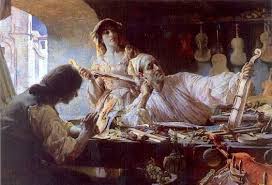The centers of excellence. Athens, Florence, Hangzhou in China, Vienna, Silicon Valley in California. The spikes on progress in our civilization.
And there is a smaller place, located on the left bank of river Po in Lombardy, in northern Italy.
Cremona. The home of violin making. The craze started in the sixteenth century in the family of Amati. Then continued with Stradivari and later on with Guarneri. The violin evolved from lira da braccio as the cello developed from viola da gamba. The wooden box designed by the grandfather of them all, Amati, was perfected by trial and error by Stradivari and Guarneri. The rest of the instrument, strings, bridge, scroll, pegs, are generally considered to be the secondaries in creating the unique sound. Except for one little stick, placed inside the box and pushing the front belly away from the back table, a sound post, there is nothing magical in the other parts. The sound post is different. By minimal, artful repositioning of this short piece of wood, a luthier can change the sound quality and loudness of the instrument. It’s so special, that it’s called anima in Italian, ame in French and dusza in Polish.
The best violins are given names as celebrities. The virtuosos are talking about them as close parts of their families and describe often as an extension of their bodies. They discuss special spiritual bonds formed between them and their instruments. The monetary values of the most famous violins are exorbitant. They often are objects of James Bond-style heists and international searches to recover them. When bought as an investment, often they are stored in banks vaults. One Texan oilman bought a Strad, locked it up in a glass case and put it in his family room for daily enjoyment.
But the instruments are meant to be played. So banks or collectors loan them to the best violin players to listen to in concert halls. A few years ago the city of Genoa lent the celebrity instrument, Guarneri’s Il Cannone, to be played in Amsterdam. Niccolo Paganini bequeathed it to the place of his birth. One can hardly imagine the security under which the violin traveled. Police with submachine guns escorted the box with the violin, meticulously wrapped in a sealed carrier, specially designated vans, extra seat on the plane and the curator from the door of the museum in Genoa to the door of the concert hall in Amsterdam.
So much hoopla!
So what’s the mystery? Or is there any?
Antonio Stradivari was an 18th century violin maker. Before he died, his son asked him the secret of his incredibly sounding violins. Antonio’s answer was that an excellent craftsman should be able to discover the secret by himself. So, the secret was buried with him.
But ever since, every so often, somebody comes out announcing he found the secret. First there was this magic forest, bosco magico, from where the wood was harvested. Then it was a special varnish with three levels of application, which made the wood sing. In modern history, spectroanalysis of scraps of the polish, dendrology of the wood, CT analysis of the thickness (or thinness) of the plates gave a little, if any, help in solving the mystery of the magical wooden creation. But to top it off, despite the emotional, highly personal relationships between the instruments and their owners, most of the objective, blinded listeners cannot hear the difference in sound.
But why in Cremona? Was it wood from bosco magico? Was it a unique, secret combination and application of varnish? Was it something in the water?
I think it was more than that. It was a culture of creating and cultivating well-selected skills. It was the system of workshops originated in the Amati family, later adopted and improved upon by the Stradivari and Guarneri families. They were able to create and work within the same system as Michelangelo and Leonardo did a little earlier. The family-owned workshop system continues to this day in Ferragamo leather goods company and used to in the Ferrari automobile factory.
I see the same system giving excellent results in the surgical training in this country. The powerhouses in surgery starting in Johns Hopkins by Halsted, Cooley in Houston, Altemeier in Cincinnati, and Sabiston in Duke, just to give but few examples, create centers of excellence by hiring a dominating personality. They design the system and require their apprentices to follow it to the minute details. Later on, when on their own, young surgeons can modify it to their liking. That system has the best chances to produce dynasties of surgeons.
So, for me, the secret is the culture of excellence.
In the clip below, James Ehnes plays his 1715 Stradivarius ‘Marsick’:
[embedyt] https://www.youtube.com/watch?v=yONTH5aWEh0[/embedyt]In the following clip, Renaud Capuçon plays the Beethoven’s Romance No.2. I’m not sure which instrument he was using; he played Stradivarius, Guarneri and Vuillaume. The only good reason I placed it here was because this composition was a part of our wedding music.
[embedyt] https://www.youtube.com/watch?v=emuin7_AOBE[/embedyt]

